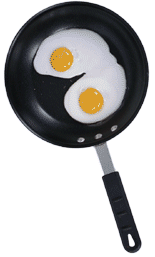
|
|
|
|
|
|||||||
|
|
|
|
|
|
|
|
|
||||
|
|
|
||||||||||
|
|
|
|
|||||||||
|
Egg
proteins change when you heat them, beat them, or mix them with
other ingredients. Understanding these changes can help you understand
the roles that eggs play in cooking.
Proteins
are made of long chains of amino acids. The proteins in an egg white
are globular proteins, which means that the long protein molecule
is twisted and folded and curled up into a more or less spherical
shape. A variety of weak chemical bonds keep the protein curled
up tight as it drifts placidly in the water that surrounds it.
When
you apply heat, you agitate those placidly drifting egg-white proteins,
bouncing them around. They slam into the surrounding water molecules;
they bash into each other. All this bashing about breaks the weak
bonds that kept the protein curled up. The egg proteins uncurl and
bump into other proteins that have also uncurled. New chemical bonds
form—but rather than binding the protein to itself, these bonds
connect one protein to another.
After
enough of this bashing and bonding, the solitary egg proteins are
solitary no longer. They’ve formed a network of interconnected
proteins. The water in which the proteins once floated is captured
and held in the protein web. If you leave the eggs at a high temperature
too long, too many bonds form and the egg white becomes rubbery.
Experiment
with heating eggs by
hard cooking eggs
,
by making
deviled eggs
, or
by making
flan
.
When
you beat raw egg whites to make a soufflé or a meringue,
you incorporate air bubbles into the water-protein solution. Adding
air bubbles to egg whites unfolds those egg proteins just as certainly
as heating them.
To understand why introducing air bubbles makes egg proteins uncurl, you need to know a basic fact about the amino acids that make up proteins. Some amino acids are attracted to water; they’re hydrophilic , or water-loving. Other amino acids are repelled by water; they’re hydrophobic, or water-fearing. Egg-white proteins contain both hydrophilic and hydrophobic amino acids. When the protein is curled up, the hydrophobic amino acids are packed in the center away from the water and the hydrophilic ones are on the outside closer to the water. When an egg protein is up against an air bubble, part of that protein is exposed to air and part is still in water. The protein uncurls so that its water-loving parts can be immersed in the water—and its water-fearing parts can stick into the air. Once the proteins uncurl, they bond with each other—just as they did when heated—creating a network that can hold the air bubbles in place. When you heat these captured air bubbles, they expand as the gas inside them heats up. Treated properly, the network surrounding bubbles solidifies in the heat, and the structure doesn’t collapse when the bubbles burst.
Experiment
with foaming egg whites by making
Pavlova
.
Mix
’em up
Everyone knows that, left to their own devices, oil and water don’t mix. But for many recipes, you mix oil-based and water-based liquids—and want them to stay that way. Often, egg yolks come to your rescue by creating an emulsion. Most food emulsions are known as the oil-in-water type, which means that oil (or fat) droplets are dispersed throughout the water. Put oil and water in a jar, shake it vigorously, and you’ll disperse the oil. To prevent the oil droplets from coalescing, however, a substance known as an emulsifier is required. Egg yolk contains a number of emulsifiers, which is why egg yolks are so important in making foods such as hollandaise and mayonnaise. Many proteins in egg yolk can act as emulsifiers because they have some amino acids that repel water and some amino acids that attract water. Mix egg proteins thoroughly with oil and water, and one part of the protein will stick to the water and another part will stick to the oil. Lecithin is another important emulsifier found in egg yolk. Known as a phospholipid, it’s a fatlike molecule with a water-loving “head” and a long, water-fearing “tail.” The tail gets buried in the fat droplets, and its head sticks out of the droplet surface into the surrounding water. This establishes a barrier that prevents the surface of the fat droplet from coming into contact with the surface of another fat droplet. Experiment with mixing oil and water by making hollandaise sauce .
|
|
|
- - - Eggs Home Page - - - |
|
|
|
|
|
|
|
|
|
|

 Beat
’em
Beat
’em
